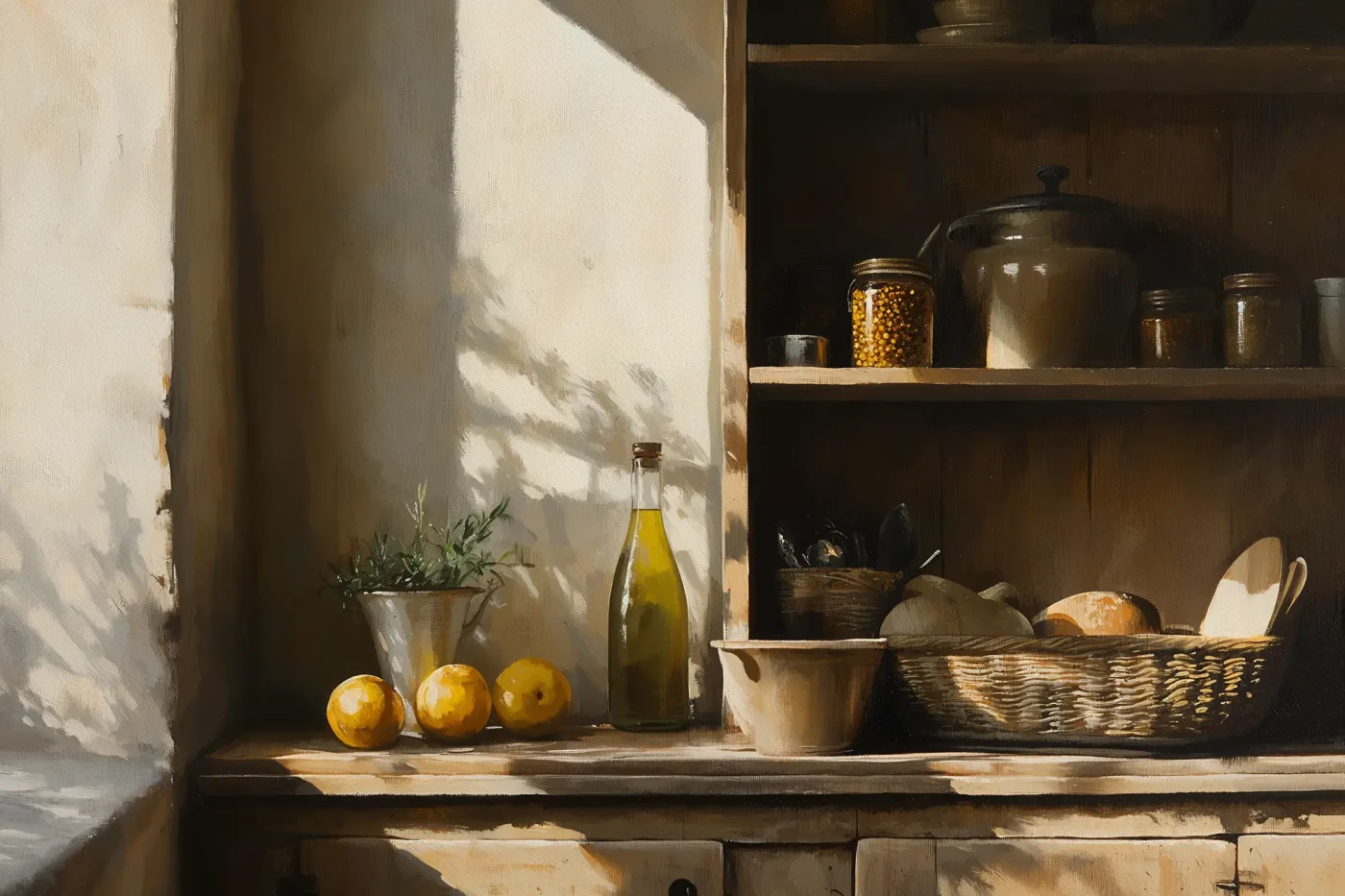I’ve always cooked a lot but lately, I find myself enjoying it in a deeper, more intentional way. Cooking relaxes me, inspires me, and grounds me. I’m a true foodie, especially when it comes to anything sweet: pastries, desserts, or little indulgent treats. What I love most is discovering new flavors, exploring different cuisines, and trying out new recipes whether they’re comforting or a bit unexpected.
I often say that to be truly happy, we need our health, close friendships (especially if love isn’t currently in the picture), family, fulfilling work… and, if we’re lucky, a good local market just around the corner ;). There’s something deeply comforting about having access to fresh, seasonal produce and being able to cook with it every day. In my family, cooking is simply part of life. We cook everything; vegetables, meat, fish, desserts, and cakes, from scratch, and always with care. When I was little, my mother rarely bought us packaged biscuits or store-bought sweets, except on special occasions. Instead, she would bake chocolate cakes, fruit tarts, and all sorts of sweet homemade delights. We were also fortunate to have fresh produce grown just outside our kitchen door, my father has always cultivated his own vegetable and fruit garden, and he keeps a few beehives as well. To this day, he still harvests his own honey whenever the bees are kind enough to share ;). That’s the kind of environment I grew up in; where cooking wasn’t just something you do, but something you live. It’s a way to share, to nurture, to connect.
And I think that says something about French culture. In France, food is serious business, but never pretentious. We grow up watching cooking shows like Top Chef, where talented young chefs from all over the country compete for the chance to open their own restaurant. Culinary professions from butchers and pastry chefs to bakers, chocolatiers, fishmongers, and caterers are admired and increasingly celebrated. They represent craftsmanship, tradition, and regional pride. What’s always struck me is how much we talk about food while we’re… eating :). I think we French may be among the few who discuss what’s on our plate even as we’re enjoying it, often already thinking about the next meal before finishing the current one. Then, of course, there’s the Michelin Guide, first published in 1900 by the French tire company, which still awards up to three stars to a select few restaurants around the world. A true symbol of just how deeply we cherish culinary excellence.
Every celebration in France takes place around a table: family gatherings like baptisms and weddings, but also religious holidays such as All Saints’ Day, Christmas, Epiphany, and Easter. Each has its own traditional dishes and rituals and even on regular weekdays, certain customs remain: the classic Sunday roast chicken with potatoes from the butcher, hearty meals slowly simmered in winter. And then there are the regional specialties, a true map of French gastronomy: Breton crêpes, Alsatian choucroute, Savoyard raclette, Marseillaise bouillabaisse, Provençal ratatouille, Burgundy beef stew, Bordeaux cannelés, Parisian macarons, Southwest cassoulet… The list is endless. In France, it’s all about taste and flavor, far more than presentation. We care that food tastes good before anything else. And if you’re a food lover (“un gourmet”) perhaps even a little indulgent (“gourmand”) like me, there are so many dishes, recipes, and local delicacies to discover that you could easily imagine a culinary Tour de France ;).
Maybe you already cook quite a bit. Maybe you’re in love with French cuisine. Perhaps you’ve tried a few of my recipes on the blog or even those passed down from my grandmother. Or maybe you’re simply curious to learn more about how the French really cook. So I thought why not share with you my French pantry checklist? It’s a sort of practical guide to the essential ingredients of French cooking. A list of staples I always keep in my pantry, the ones that allow me to prepare, quite effortlessly, around 95% of the recipes I make day to day. In this French pantry checklist, you’ll find a bit of everything: spices, condiments, dairy, seasonings, and all those everyday essentials that make up the heart of French cuisine.
I hope you’ll enjoy this new article! And if you have any questions or would like to share your own favorite pantry items feel free to leave a comment below :).
My French Pantry Checklist
1. Oils, Vinegars & Condiments
- Extra-virgin olive oil (cold-pressed) — I cook almost everything with olive oil from hot dishes like ratatouille, roasted vegetables, meats, or fish, to cold preparations like salads.
- Unsalted or salted butter — A pantry essential in French baking, whether you’re making sweet or savory tarts, cakes, or pastries. Choose whichever version you prefer.
- Balsamic vinegar (my favorite!) or apple cider vinegar — Perfect for making vinaigrettes to dress all kinds of salads.
- Dijon mustard — A must-have for homemade vinaigrettes and mayonnaise.
- Guérande sea salt — I love seasoning dishes with this delicate, flaky sea salt, a staple in French kitchens.
- Whole black pepper (in a grinder) — I always buy whole peppercorns and grind them fresh with my Peugeot pepper mill.
2. Herbs, Aromatics & Spices
- Herbes de Provence — A classic French blend (rosemary, basil, oregano, thyme, marjoram, and savory) that I use regularly to season dishes and sauces. An absolute essential.
- Persillade — A dried mix of garlic, shallots, and parsley. It’s absolutely delicious in green salads or on grilled meats with a little melted butter. It adds instant flavor and depth.
- Bouquet garni (thyme, bay leaf, sage, rosemary) — This traditional blend of dried herbs is a French classic, perfect for adding aroma and complexity to slow-cooked dishes.
- Dried spices (easy to store) — I always keep curry, cumin, ginger, cardamom, coriander, nutmeg, turmeric, cloves, cinnamon, thyme, dill, oregano, basil, tarragon, chili flakes, and paprika. Choose what suits your style, these can last for years and elevate the simplest recipes.
- Garlic, yellow or red onions, and shallots — Basic aromatics I reach for almost every day, they form the foundation of countless French dishes.
3. Dairy & Eggs
- Grated cheese (Emmental in France) — Perfect for croque-monsieur, quiches, savory tarts, or simply sprinkled over fresh pasta.
- Long-life liquid cream — In France, this shelf-stable cream is found in the dry goods aisle. I love using it in place of crème fraîche, it keeps longer and is so versatile for everyday cooking.
- Semi-skimmed milk (preferably organic) — A key ingredient in many cake recipes to add moisture and softness.
- Eggs (preferably organic) — A staple in nearly every French recipe sweet or savory.
4. Grains, Legumes & Pantry Basics
- Lentils (green or otherwise) — I often make warm lentils with a touch of Dijon mustard, onions, and lardons. A simple and hearty dish I never get tired of.
- Chickpeas or white beans (dry) — Great for stews, salads, or even quick purées. I always keep a few on hand.
- Rice and pasta — I tend to favor fresh pasta, and I’d love to start making my own (I just need to get the pasta machine)! In the meantime, I always keep some good-quality rice and dry pasta in the pantry for easy weekday meals.
- Potatoes — A true staple in the French kitchen, perfect for gratin dauphinois, creamy mashed potatoes, or pan-fried with butter and persillade.
- Bouillon cubes or powder (vegetable, chicken, or beef) — I use these often to flavor soups, sauces, or risottos when I don’t have homemade broth on hand.
- Nuts (walnuts, hazelnuts, etc.) — I love tossing them into salads for crunch or using them in baking for added richness.
- Breadcrumbs (chapelure de pain) — I always keep a jar of fine breadcrumbs in my pantry, perfect for coating chicken or fish before pan-frying. It’s such a simple and delicious way to prepare a quick meal. One of these days, I’ll share the recipe I use at home ;).
5. Baking Essentials
- Flour (Type 45 or Type 55) — I always keep both on hand. Type 55 flour is slightly less refined than Type 45, meaning it contains a bit more of the wheat bran. The more whole the flour, the better it tends to be nutritionally, as the bran is rich in fiber and slow-release carbohydrates. Type 45 is ideal for light cakes and pastries, while Type 55 is perfect for breads, tarts, and doughs that need more structure.
- Cornstarch (Maïzena) — Perfect for making pastry creams or lemon custard, lightening cakes, or thickening sauces without flour.
- Almond flour (or ground almonds) — Wonderful in cakes, tart crusts, and even for adding texture to shortcrust pastry.
- Dark chocolate baking bars (at least 53% cacao) — I always keep a bar or two in my pantry. Perfect for cakes, cookies, or anything chocolatey.
- Three types of sugar: icing sugar, brown sugar (cassonade) and classic white sugar. Each one has its own purpose in French baking.
- One or two vanilla pods — For infusing cakes, creams, flans, custards, and biscuits with a beautiful natural aroma.
- Orange blossom water (fleur d’oranger) — This delicate floral essence is one of my favorite ingredients for flavoring cakes, biscuits, and of course madeleines.
- Baking powder: essential for most cake recipes. I recommend using a good-quality brand. In France, Alsa is the go-to.
- Instant dried baker’s yeast — Activate it with a little warm water or milk, it’s very handy if you don’t have fresh yeast on hand. In France, you can often ask your local baker for a bit of fresh yeast directly.
6. Sweet Additions, Citrus & Teas
- Real honey — Be sure to check the label. Many commercial honeys are blended with glucose syrup or added sugars. Choose a pure, high-quality honey whenever possible.
- Lemons (preferably organic) — Great for flavoring cakes, cookies, vinaigrettes, or fish. I always keep a few in my kitchen.
- Dried herbs for herbal teas (preferably organic) — I adore mint (both sweet and peppermint) but I also keep verbena, chamomile (lovely in the evening), and eucalyptus, which I infuse with lemon and a spoonful of honey whenever I catch a cold.
- Flavored green or black tea — My favorites are from Mariage Frères. I especially love Casablanca, Opéra Blue, and Boléro, they’re truly special!
- Jams & fruit preserves — Delicious on warm brioche or fresh bread at breakfast, or perfect for making a quick jam-filled sponge roll.
- Unsweetened cocoa powder — A baking essential, ideal for flavoring cakes or simply making a rich, cozy cup of hot chocolate.
Et voilà! I hope I didn’t forget anything, but if something’s missing, do let me know. I always love discovering what others keep tucked away in their pantries ;).



